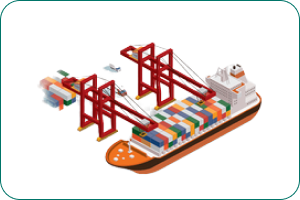Unlocking Global Trade: Biobaxy's Transshipment Service
In the era of globalization, international trade has become the lifeblood of economies worldwide. The movement of goods across borders is a complex and delicate operation, requiring seamless coordination and innovative solutions. Biobaxy, a company known for its excellence in various sectors, has made its mark in the world of logistics through its Transshipment Service.
Biobaxy's transshipment service is not merely a logistics operation; it is a crucial cog in the wheel of global trade. With a commitment to efficiency, transparency, and sustainability, Biobaxy is setting new standards in the world of transshipment. As international trade continues to grow and evolve, companies like Biobaxy play a vital role in facilitating the movement of goods across borders, ensuring that the global economy thrives.
Biobaxy's Role in Transshipment:
Biobaxy, a company that has established itself as a leader in various industries, recognizes the significance of transshipment in the global supply chain. The company's transshipment service is a testament to its commitment to streamlining logistics and bolstering international trade.
An Overview of Transshipment
In the intricate world of logistics and global trade, transshipment is a critical operation that often goes unnoticed but plays a pivotal role in ensuring the smooth flow of goods from one location to another. Transshipment is the process of transferring cargo or goods from one mode of transport to another, often occurring at a central hub or interchange point. This function is a fundamental component of international shipping, serving to optimize transportation routes and reduce the time and cost associated with moving goods across vast distances.
At its essence, transshipment involves the unloading of cargo from one vehicle or vessel and reloading it onto another. This can occur in various scenarios, including at ports, airports, or transportation hubs where multiple transportation modes converge.
Key Aspects of Transshipment
- Efficiency Transshipment operations are designed to be highly efficient. They aim to minimize delays and ensure that cargo is transferred swiftly between modes of transportation to keep goods moving smoothly.
- Hub Function Major ports, airports, and transportation hubs often serve as critical transshipment hubs, where cargo from various origins is consolidated, sorted, and reloaded onto other transportation methods, such as trucks, trains, or ships.
- Route Optimization One of the primary goals of transshipment is to optimize transportation routes. This involves selecting the most cost-effective and efficient paths for goods in transit, considering factors such as distance, time, and available transportation options.
- Inventory Management Effective transshipment requires careful inventory management. Keeping track of incoming and outgoing goods, as well as ensuring their security during the transfer process, is a key aspect of these operations.
- Real-Time Tracking To maintain transparency and provide real-time information to clients, many transshipment operations employ advanced tracking systems that allow customers to monitor the status and location of their cargo as it passes through various stages of transshipment.
Transshipment is a critical function in the logistics and global trade landscape, ensuring the efficient and cost-effective movement of goods across vast distances. It is an often-underappreciated element of the supply chain that plays a fundamental role in the modern interconnected world.
Understanding Transshipment: A Vital Link in Global Trade
Transshipment is the process of transferring goods from one vessel, truck, or aircraft to another for further transport. It typically occurs at a central hub, often a major port or transportation node, where cargo is transferred between various transportation modes or consolidated to be dispatched to its final destination.
This process is pivotal in international trade because it allows for the efficient movement of goods between different regions and nations. It optimizes routes, minimizes transportation costs, and ensures that products reach their intended destinations on time.

Advantages of Transshipment:
Shipping Partners



















